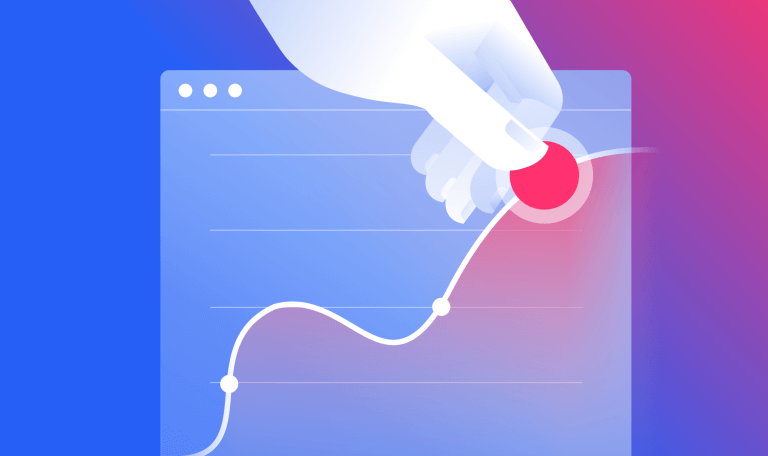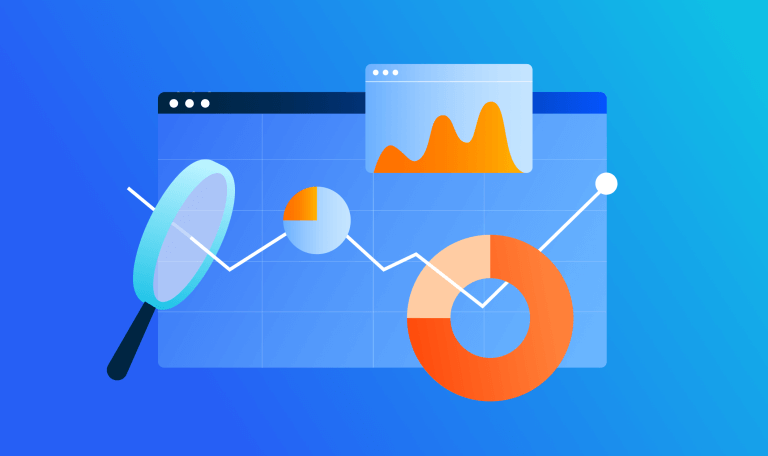Bounce Rate Explained: Everything You Need to Achieve Growth

We’ve all been there – that moment you notice your traffic and engagement metrics are dipping. Visitors are arriving at your website, but they’re leaving at an alarmingly high (and fast) rate. In a frenzy, you search through all your data and rummage through different digital metrics to try and find the culprit.
While bounce rate seems to convey a simple message – how quickly people leave your site or a specific landing page – understanding its true implications requires a deeper dive. Not everyone who bounces is a disappointed visitor. In this post, we’ll share insights on what you can realistically expect from your bounce rate and how to effectively measure and optimize your website for growth.
Try Similarweb free for digital insights on demandWhat is a bounce rate?
Simply put, bounce rate is the percentage of visitors who leave your site without performing a desired action, which can be anything from clicking away to another webpage, watching a video, or selecting to “read more.” A bounce indicates how many visitors “came, saw, and left”.
According to Google Analytics, bounce rate measures the percentage of single interaction visits to your site. The user “bounces” back from the same page they entered without sending any additional trigger to the analytics server.
Keep this in mind because it will help you make sense of the numbers as we dive deeper.
Bounce rate vs. exit rate
Bounce rate measures how often visitors exit your website without visiting anything else. Exit rate measures the percentage of visitors who leave from a particular page, after already visiting other pages on your website. The last page – the one they left from – is considered the exit page and will be measured to calculate the exit rate.
The main difference here is that bounce rate inherently only tracks single-page interactions, whereas exit rate tracks what happens after a visitor browses through your content.
How is bounce rate calculated?
Bounce rate is calculated by dividing single-interaction visits by total visits to your site, giving you the percentage of total visits during a set period.
Bounce Rate = Single-Page Visits (Bounces) ÷ Total Visits (Sessions)
For example, if you had 500 visitors to your homepage on day X and 250 left without taking action, your bounce rate on day X is 50%. This includes visitors who remained on the page until the session timed out.
To use this metric efficiently, you can measure and track bounce rates for specific pages or page groups. This is critical for understanding user experience and can be a great help when optimizing your site.
What is an average bounce rate?
Usually, the lower the bounce rate is, the better. After all, you want people to take maximum interest in your site. But there are several factors to consider before you decide that your site needs fixing.
In general, you should expect your website’s bounce rate to be anywhere between 26%-70%. The average worldwide for all industries in October 2021 was 30.5%. However, for certain industries, like eCommerce, the norm may not be good enough. In order for consumers to make a purchase, they’ll browse through multiple pages on a website – a 30% bounce rate means that many are leaving without metaphorically flipping through the racks.
Take a look at the average bounce rates per industry according to Similarweb website analytics:
Why do average bounce rates vary per industry?
As you can see from the chart above, your ideal bounce rate depends on the industry you’re in. Think about it: a visitor to an eCommerce site is like a customer in a store. They look at various items before buying or leaving. The intention of a visitor to a news site, blog, or dictionary is entirely different and is typically single-page sessions. People are looking for a specific piece of information and will usually leave right after they find it.
Consider your traffic channels
Although it’s an important starting point, your industry is not your only factor.
Similarweb analytics reveal that visitors arriving through email and referral are least likely to bounce while traffic from display ads or social media produces the highest bounce rate.
Use these benchmarks for an overall evaluation. For a serious analysis and to reach decisions on how to increase website traffic, you’ll need more precise numbers and want to compare with your direct competitors.
Don’t forget that a page’s bounce rate alone doesn’t tell you much about performance. To understand what the numbers indicate, you’ll need to look at additional engagement metrics, such as session duration, page speed, and ranking factors in correlation.
Mobile web vs. desktop traffic
Before you move on to analyzing additional data, consider one more significant variable: the device. How your target audience gets to your website is important – user intent and useability can vary significantly between desktop and mobile traffic.
At Similarweb, we crunched the numbers and found a variance of more than 16% in mobile and desktop bounce rates.
Why is my bounce rate high?
Don’t worry if you’ve looked through some of the industry benchmarks and you’re not performing at the level you want to be. There are a few explanations for why you may have a higher bounce rate than the standard:
The page does not meet the visitor’s expectation
This is the first reason that jumps to mind. The user was looking for one thing and found something else. Search intent and page content do not match.
Why does this happen?
- The page could be optimized for the wrong keywords
- Ad content may have raised expectations that the page doesn’t meet
- The answer to the visitor’s query is not immediately visible
- Customers find plugins or other add-ons annoying, affecting usability
Any of these factors could explain a bad bounce rate, but they also give you actionable takeaways to improve it.
Visitors find what they are searching for…fast
A high bounce rate is not necessarily a bad sign. If a person with a specific intent found the exact answer to their query, they have no reason for further action. Take the weather forecast on a news portal as an example, where people sign in to quickly check the local temperature and carry on with their day.
On most sites, you would still strive to lower your bounce rate. Why? Because getting visitors to browse additional pages indicates that your website provides additional value and has a positive impact on your SEO. Try adding relevant internal links to other content or product pages to keep users on your site.
Low-quality page or content
Never underestimate the impact of poor page quality. An unattractive design can cause people to turn back and ultimately tank user engagement. Too many irrelevant items can distract the focus. Small text or a font that isn’t easily readable presents an obstacle. Nobody wants to work hard to get what they came to find.
A few questions to ask yourself:
- Is my UX intuitive, or could visitors find it awkward?
- Does the page load fast enough?
- Is the call-to-action button (CTA) obvious and compelling enough?
- Is the page mobile-friendly?
- Is my content accurate, well-written, and engaging?
Make sure the page does not produce an error, and your analytics are set up correctly. These issues can sometimes wrongly produce a low bounce rate. If you have an extremely low one, outside the normal range, it should raise a red flag.
Also remember, the bounce rate counts single-interaction visits. A pop-up on the page, an auto-play video, or any other event occurring on the page will send an additional trigger to analytics. In this case, the visit does not count as a bounce, even though there was no interaction.
How can I reduce my bounce rate?
There are a number of ways that you can address and improve a high bounce rate. Here are some popular tips and tools that you can use to lower yours:
- Format your content and make sure it’s highly readable, has good style, and correct grammar. You can test how readable your site is with WebFX’s Readability Test Tool
- Make your CTA buttons clear and easy to understand. Customers who don’t understand your product are usually the most likely to bounce
- Improve your website’s page load time to increase your traffic and customer satisfaction. Google’s PageSpeed Insights is a good tool for checking this
- A/B test your copy and creatives to see what’s working the best. Tap into user behavior recording tools to monitor your visitors’ reactions
- Consider incorporating Live Chat support into your website to connect with visitors before they leave your website
- Dig into competitive benchmarks to compare where you stand and set reasonable goals for improvement
- Use heat maps or screen recordings, like those available from Hotjar, to understand customer behavior and how much time users spend on different parts of your site.
Track and monitor your competitors’ bounce rates
We’ve talked a lot about benchmarking to understand what your data tells you. With access to the right data, you can make better business decisions based on a bounce rate comparison by handpicking your competitors.
Benchmark your bounce rate against the competition
Using Similarweb, choose up to four of your toughest competing sites and compare their bounce rates to yours across set time periods.
Simply looking at the sites with high traffic and low bounce rates can give you an idea of what they have in common that works well. If your site performs best, pat yourself on the back, but keep tracking.
Let’s take it a step further. Connect overall bounce rate with marketing channel data. First, check for your own site. If, for example, the traffic from display ads is exceptionally high, but so is the bounce rate, that’s not effective.
Then compare with the competitors you picked and see how their pages perform.
If you discover that your paid search is under-performing (i.e., Target in the example above), you need to investigate why. Check the pages of the top-performing competitors. Don’t copy, just try to understand what works. Make one change to your page and measure again. Keep adjusting, testing, and tracking. Watch your bounce rate shrink and your site engagement grow.
Additionally, reports can easily be exported from the Similarweb platform, which you can then share with your team members – allowing you to showcase successes or highlight areas that need improvement.
To learn more about the specific engagement metrics in your industry, set up a live demo with one of Similarweb’s product experts.
Bounce Rate FAQ
What is bounce rate?
Bounce rate represents the percentage of visitors who enter the site and then leave, or “bounce”, rather than continuing to view other pages within the same site.
How is bounce rate calculated?
Bounce rate is calculated by the total number of single-page visits divided by the total number of entries to a website.
What is an average bounce rate?
The average worldwide for all industries in October 2021 was 30.5%.
What is a good bounce rate?
The lower the bounce rate, the better – however, this varies by industry. For example, the average bounce rate for a quick-hit reference site is 46.1% while the average bounce rate for something more time-consuming, like TV, Movies, & Streaming is 20.5%.
Why is my bounce rate high?
The page doesn’t meet the visitor’s expectations or search intent and page content do not match. Alternately, visitors find what they’re looking for too quickly or the page and its content are low-quality.
Track your digital metrics and grow market share
Contact us to set up a call with a market research specialist













